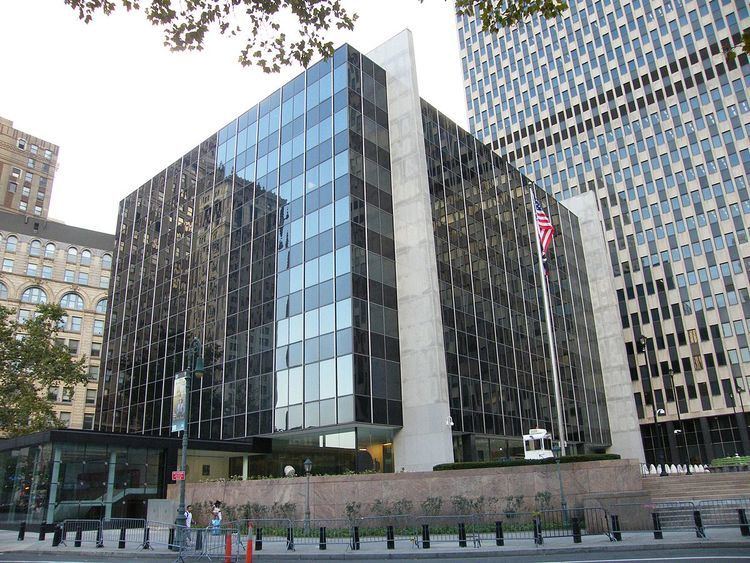Established 1980 Authorized by | Country United States Judge term length Life tenure | |
 | ||
Location Lower Manhattan, New York City Composition method Presidential nomination with Senate confirmation | ||
The United States Court of International Trade, formerly the United States Customs Court, and before that the Board of General Appraisers, is an Article III court, with full powers in law and equity. The Customs Court Act of 1980 replaced the old United States Customs Court with the United States Court of International Trade. The Court has nine sitting Judges, as well as Senior Judges. The Court sits in New York City, although it is authorized to sit elsewhere, including in foreign nations.
Contents
History
In 1890, the United States Congress passed legislation creating the Board of General Appraisers, a quasi-judicial administrative unit within the United States Department of the Treasury. The Board had nine members appointed by the President of the United States and empowered to review decisions of United States Customs officials concerning the amount of duties to be paid on importations.
In 1926, Congress responded to the increasing number and complexity of customs cases by replacing the Board of General Appraisers with the United States Customs Court, an independent Article I tribunal, retaining the jurisdiction and powers of the Board of General Appraisers. In 1928, the United States Customs Court became the first federal tribunal in the United States to have a woman judge, when President Calvin Coolidge nominated Genevieve R. Cline to the court. Although many members of the United States Senate objected to Cline's appointment, both because of her gender, and because they believed she was self-taught and had no judicial experience, her supporters advocated strongly for her, including Katherine Pike, president of the National Association of Women Lawyers and a number of club-women. Cline won U.S. Senate confirmation on May 25, 1928, received her commission on May 26, 1928, and took her oath of office in the Cleveland Federal Building on June 5, 1928.
In 1956, Congress made the United States Customs Court an Article III tribunal, again without changing its jurisdiction, powers, or procedures. After making some procedural changes in the Customs Courts Act of 1970, Congress addressed substantive issues concerning the court's jurisdiction and remedial powers in the Customs Courts Act of 1980, which broadened the power of the court and renamed it the United States Court of International Trade.
Jurisdiction
The Court possesses limited subject matter jurisdiction, meaning that it may hear only cases involving particular international trade and customs law questions. For example, the Court hears disputes such as those involving protests filed with U.S. Customs and Border Protection, decisions regarding Trade Adjustment Assistance by the United States Department of Labor or United States Department of Agriculture, customs broker licensing, and disputes relating to determinations made by the United States International Trade Commission and the Department of Commerce's International Trade Administration regarding anti-dumping and countervailing duties.
There is one notable exception to the Court's jurisdiction. In cases involving antidumping and countervailing duties imposed on Canadian or Mexican merchandise, an interested party can request that the case be heard before a special ad hoc binational panel organized under Chapter 19 of the 1988 Canadian-U.S. Free Trade Agreement.
Procedure
Most cases are heard by a single judge. If a case challenges the constitutionality of a U.S. law or has important implications regarding the administration or interpretation of the customs laws, then it may be heard by a three-judge panel. Many Judges of the Court of International Trade also regularly sit by designation on three-judge panels of the United States Court of Appeals for the Second Circuit.
Although the Court maintains its own rules of procedure, they are patterned for the most part on the Federal Rules of Civil Procedure. The court has held that decisions interpreting the Federal Rules of Civil Procedure are "instructive" in interpreting its own rules.
Courthouse
The James L. Watson Court of International Trade Building, located on Foley Square in lower Manhattan in New York City, houses the court. Also known as 1 Federal Plaza, it was built in 1968 adjacent to the Jacob K. Javits Federal Building.
In 2003, the building was named in honor of James L. Watson, a judge of the United States Customs Court from 1964 to 1980, and of the Court of International Trade from 1980 to 2001.
Judges of the United States Court of International Trade
(current as of September 15, 2016)
